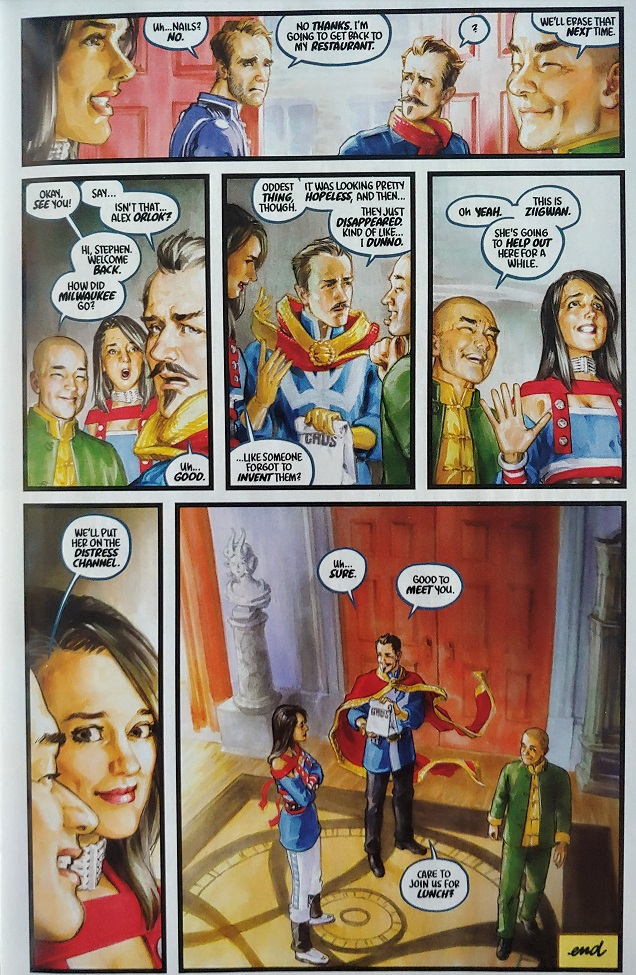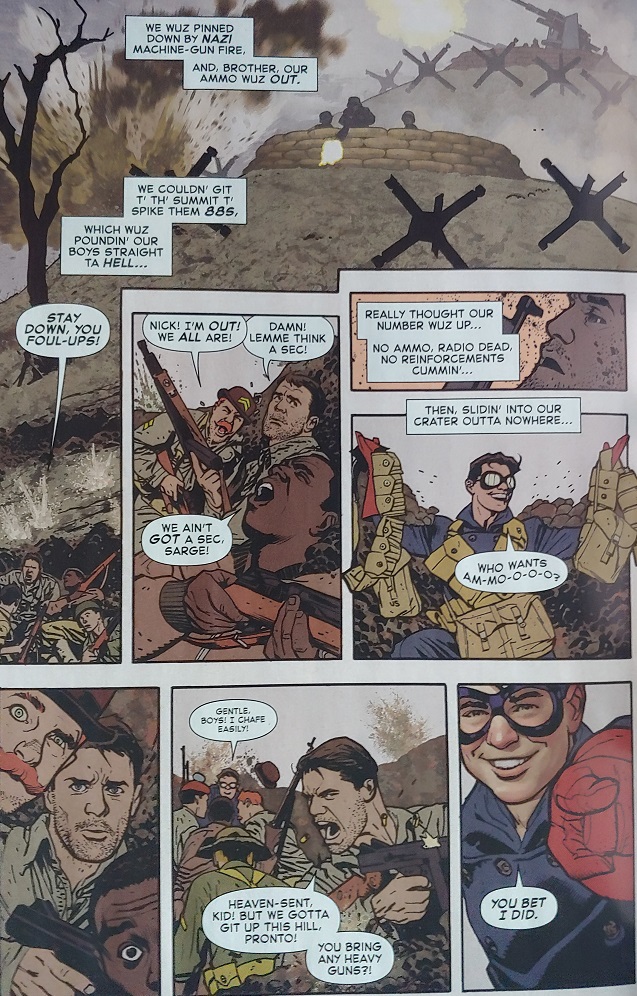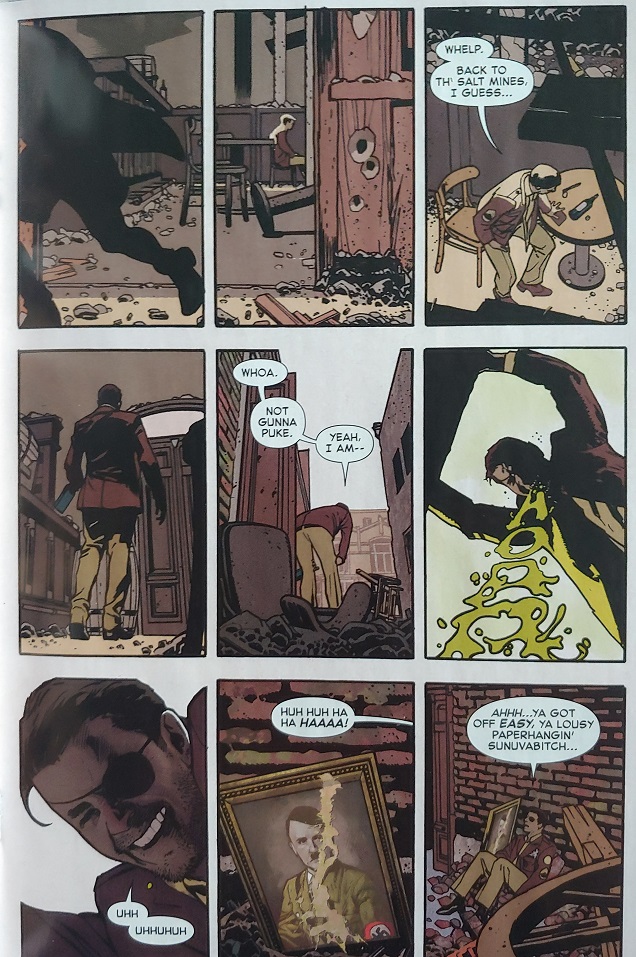Exactly a year ago I started reviewing Marvel, an anthology series in which so many talented creators have participated. Here, as in previous issues, the opening pages are by Alex Ross and Steve Darnall. Nightmare has defeated Doctor Strange and has acquired so much power that he can now defy invincible cosmic entities such as the Supreme Tribunal and Eternity. Alex Ross’ art is absolutely beautiful, his interior pages are a joy to behold, and so is his cover, a vibrant composition in which many of Marvel’s heroes are descending from the skies.
 |
| Alex Ross |
Although previous issues had a combination of established artists with newcomers, this one is 100% pure talent. Every single artist in this issue is of legendary status in the comic book industry: Gene Ha, especially thanks to his collaboration with Alan Moore in Top Ten: The Forty-Niners. After that we have Adam Hugues, who is perhaps more famous for his covers but who also happens to be amazing doing interior art. And finally Lucio Parrillo, who hasn’t collaborated much for Marvel in the past which makes this a special occasion.
 |
| Alex Ross |
“A Day In The Mystical Life” (April 2021) revolves around the Sorcerer Supreme, Doctor Strange, before his confrontation with Nightmare. One of my favorite artists, Gene Ha, writes and pencils this story, longtime collaborator Zander Cannon inks it. I absolutely enjoyed this day in the mystical life of Doctor Strange, who happens to be in Milwaukee, of all places, with the rest of the Avengers, while his loyal Wong, in New York, must help Strange in a very unexpected way. Great story and great art!
 |
| Gene Ha |
Adam Hughes writes, illustrates and colors “The Best of Us”, a very special story about WWII and Captain America. Although Hughes is incredibly famous as an artist, this is one of the rare opportunities in which we get to see how talented he is as a writer. In a short but captivating tale, Hughes talks about the war and the aftermath of a conflict that changed the history of the world. In the process, we get too see many familiar faces such as Nick Fury and Dum Dum Dugan from SHIELD, but also Bucky, Cap’s sidekick.
 |
| Gene Ha |
It’s especially interesting to see a lonely Nick Fury getting drunk while reminiscing the pivotal moments of the war and the participation of the Sentinel of Liberty. When the world thought Captain America and Bucky had died, what was the reaction of those closest to them? This is a unique insight into the mind of character that has always been secretive and hermetic, as he should be giving his role as a top spy, and I must say the ending was particularly inspiring.
 |
| Adam Hughes |
At last but not least, we have “Wolverine” written by Mark Waid with art by Lucio Parrillo, another magnificent illustrator who applies photorealism to action-packed compositions, creating very strong a vibrant results. This story connects to Wolverine’s first appearance, when he fights against the Hulk. Unbeknownst by the mutant with adamantium claws, the fight is being observed by Professor X and Cyclops who have very different opinions about whether Wolverine would be a suitable candidate for the X-Men or not.
________________________________________________________________________________________________________
________________________________________________________________________________________________________
Hace exactamente un año comencé a reseñar Marvel, una serie antológica en la que han participado muchos creadores talentosos. Aquí, como en números anteriores, las primeras páginas son de Alex Ross y Steve Darnall. Nightmare ha derrotado al Doctor Strange y ha adquirido tanto poder que ahora puede desafiar a entidades cósmicas invencibles como el Tribunal Supremo y Eternidad. El arte de Alex Ross es absolutamente hermoso, sus páginas interiores son un placer para la vista, al igual que su portada, una composición vibrante en la que muchos de los héroes de Marvel descienden de los cielos.
 |
| Adam Hughes |
Aunque los números anteriores tenían una combinación de artistas establecidos con recién llegados, este número es 100% puro talento. Aquí todos los artistas tienen un estatus legendario en la industria del cómic: Gene Ha, famoso gracias a su colaboración con Alan Moore en Top Ten: The Forty-Niners. Después de eso tenemos a Adam Hugues, que es quizás más famoso por sus portadas pero que también es increíble haciendo arte en las páginas interiores. Y finalmente Lucio Parrillo, quien no ha colaborado mucho con Marvel en el pasado, lo que hace de esta una ocasión especial.
 |
| Adam Hughes |
“Un día en la vida mística” (abril de 2021) gira en torno al Hechicero Supremo, Doctor Strange, antes de su enfrentamiento con Nightmare. Uno de mis artistas favoritos, Gene Ha, escribe y dibuja a lápiz esta historia, el colaborador habitual Zander Cannon la entinta. Disfruté muchísimo este día en la vida mística del Doctor Strange, quien casualmente está en Milwaukee, de todos los lugares, con el resto de los Vengadores, mientras que su leal Wong, en New York, debe ayudar a Strange de una manera muy inesperada. Gran historia y gran arte!
 |
| Lucio Parrillo |
Adam Hughes escribe, ilustra y colorea “Lo mejor de nosotros”, una historia muy especial sobre la Segunda Guerra Mundial y el Capitán América. Aunque Hughes es increíblemente famoso como artista, esta es una de las raras oportunidades en las que podemos ver su talento como escritor. En una historia breve pero cautivadora, Hughes habla sobre la guerra y las consecuencias de un conflicto que cambió la historia del mundo. En el proceso, también vemos muchas caras conocidas, como Nick Fury y Dum Dum Dugan de SHIELD, pero también está Bucky, el ayudante juvenil del Capi.
 |
| Lucio Parrillo |
Es especialmente interesante ver a un Nick Fury solitario emborrachándose mientras recuerda los momentos cruciales de la guerra y la participación del Centinela de la Libertad. Cuando el mundo pensó que el Capitán América y Bucky habían muerto, ¿cuál fue la reacción de los más cercanos a ellos? Esta es una mirada única a la mente de un personaje que siempre ha sido reservado y hermético, como corresponde a su papel como espía, y debo decir que el final fue particularmente inspirador.
 |
| Lucio Parrillo |
Por último, pero no menos importante, tenemos "Wolverine" escrito por Mark Waid y con arte de Lucio Parrillo, otro ilustrador magnífico que aplica el fotorrealismo a composiciones llenas de acción, creando resultados muy sólidos y vibrantes. Esta historia se conecta con la primera aparición de Wolverine, cuando lucha contra Hulk. Si que el mutante de las garras de adamantium lo sepa, la pelea está siendo observada por el Profesor X y Cíclope, quienes tienen opiniones muy diferentes sobre si Wolverine sería un candidato adecuado para los X-Men o no.






























